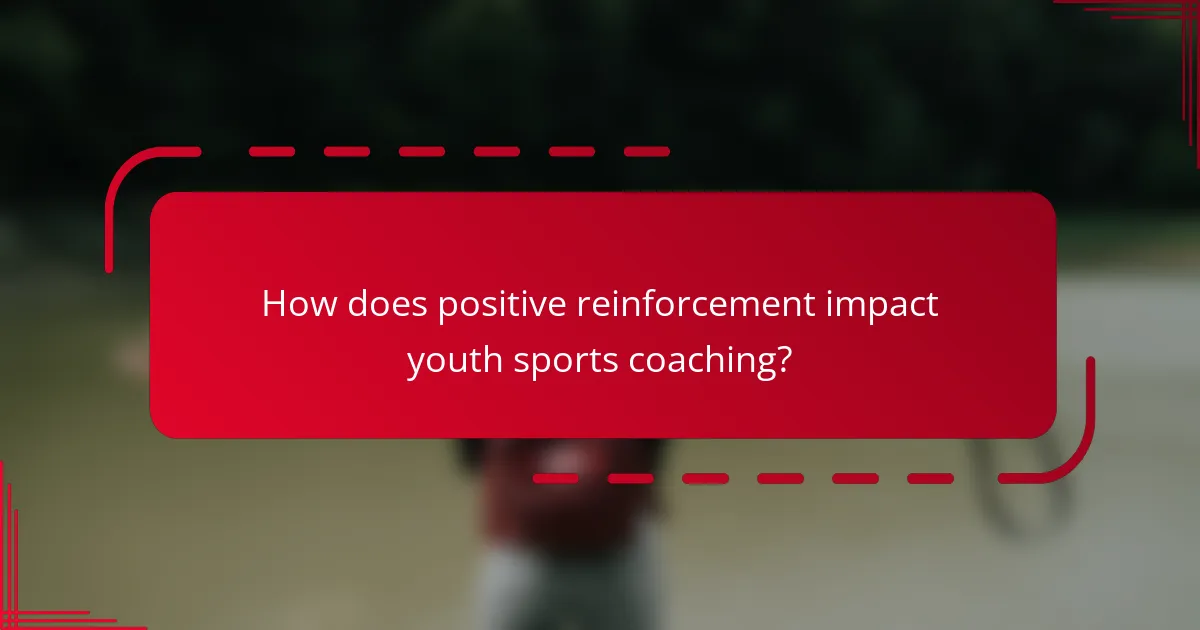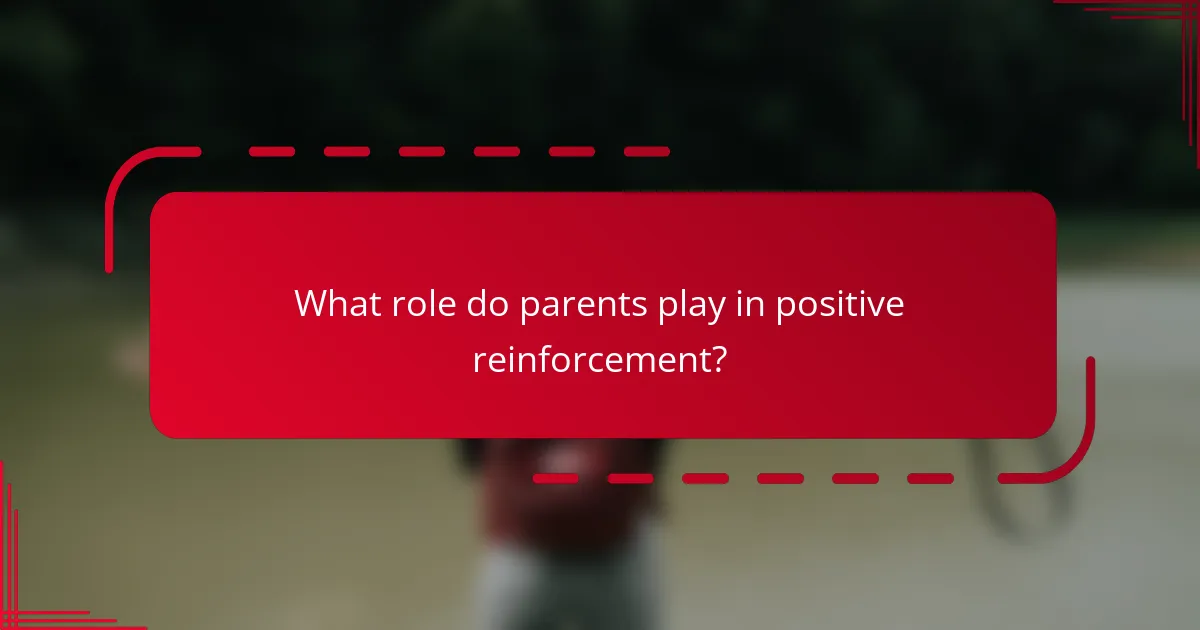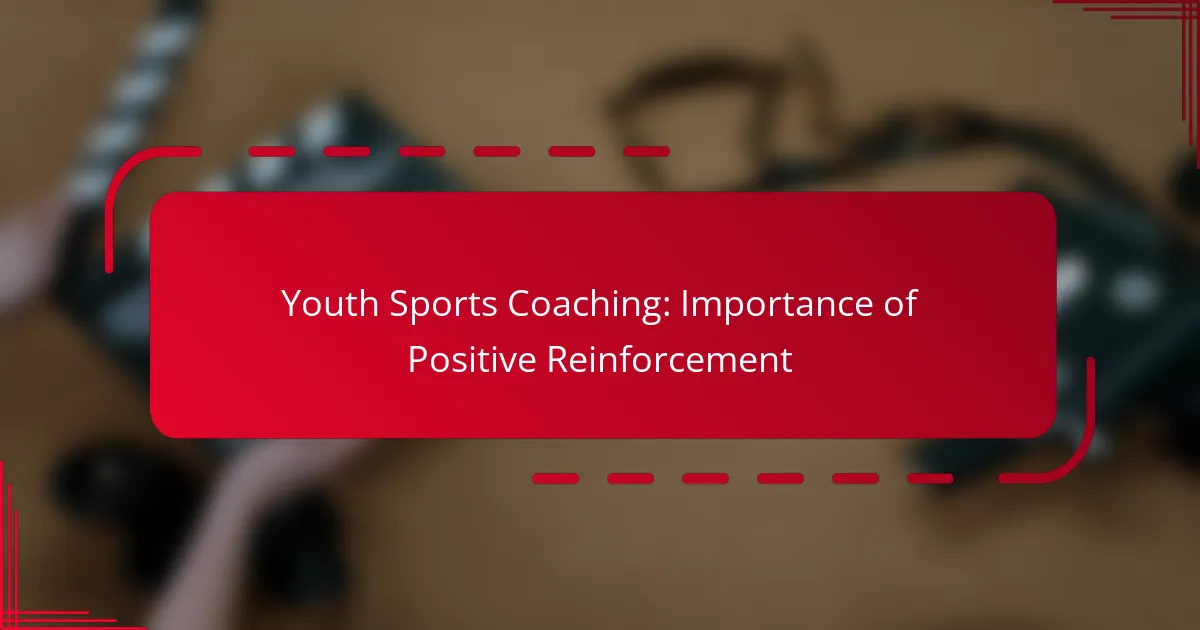Positive reinforcement plays a crucial role in youth sports coaching by fostering desired behaviors and enhancing overall performance. By effectively utilizing praise and rewards, coaches can create a supportive environment that builds confidence, motivation, and a lasting love for the sport among young athletes.

How does positive reinforcement impact youth sports coaching?
Positive reinforcement significantly enhances youth sports coaching by encouraging desired behaviors and improving overall performance. Coaches who utilize praise and rewards effectively can create a more engaging and supportive environment for young athletes.
Enhances athlete motivation
Positive reinforcement boosts athlete motivation by recognizing and rewarding effort and achievement. When young athletes receive praise for their hard work, they are more likely to remain engaged and committed to their training and competition. This can lead to increased participation and enthusiasm for the sport.
Coaches can enhance motivation by setting achievable goals and celebrating milestones. For example, acknowledging a player’s improvement in skills or teamwork can inspire them to push further and strive for excellence.
Improves skill development
Using positive reinforcement in coaching helps athletes develop their skills more effectively. When players receive constructive feedback along with encouragement, they are more likely to focus on improving their techniques and performance. This approach fosters a growth mindset, where athletes view challenges as opportunities to learn.
Coaches should provide specific praise related to skill execution, such as complimenting a player’s footwork or decision-making during a game. This targeted reinforcement helps athletes understand what they are doing well and what they can continue to work on.
Builds self-esteem
Positive reinforcement plays a crucial role in building self-esteem among young athletes. When coaches consistently acknowledge their efforts and successes, players develop a stronger belief in their abilities. This confidence can translate into better performance both on and off the field.
Coaches can foster self-esteem by creating a supportive atmosphere where mistakes are viewed as part of the learning process. Encouraging athletes to reflect on their progress and celebrating their achievements, no matter how small, can significantly enhance their self-worth and resilience.

What are effective positive reinforcement strategies?
Effective positive reinforcement strategies include techniques that encourage desired behaviors in youth sports through rewards and recognition. These strategies help build confidence, motivation, and a love for the sport.
Verbal praise
Verbal praise is a straightforward yet powerful method of positive reinforcement. Coaches should offer specific compliments that highlight what the athlete did well, such as “Great job on that pass!” This not only boosts the athlete’s confidence but also reinforces the behavior you want to see repeated.
To maximize the impact of verbal praise, ensure that it is timely and sincere. Offering praise immediately after a good performance or effort helps athletes connect the positive feedback with their actions, making it more effective.
Reward systems
Implementing a reward system can motivate young athletes by providing tangible incentives for achieving specific goals or demonstrating good sportsmanship. Rewards can range from stickers and certificates to small prizes, depending on the level of achievement.
When designing a reward system, consider setting clear criteria for earning rewards. This could include completing a certain number of practices, showing improvement in skills, or exhibiting teamwork. Ensure that rewards are attainable and encourage healthy competition among players.
Goal setting
Goal setting is an essential strategy for positive reinforcement in youth sports. By helping athletes set realistic and achievable goals, coaches can provide a clear path for improvement and success. Goals should be specific, measurable, and time-bound, such as “Improve your free throw percentage by 10% by the end of the season.”
Encourage athletes to track their progress towards these goals, which can enhance their motivation and commitment. Regular check-ins to discuss their achievements and challenges can also reinforce their efforts and keep them engaged in their development.

How can coaches implement positive reinforcement in practice?
Coaches can implement positive reinforcement by consistently acknowledging players’ efforts and achievements, which boosts their motivation and confidence. This approach involves specific strategies that create a positive atmosphere conducive to learning and growth.
Consistent feedback
Providing consistent feedback is crucial for reinforcing positive behaviors in young athletes. Coaches should regularly highlight what players are doing well, whether it’s a good pass, teamwork, or effort during practice. This feedback should be immediate and specific to help players understand exactly what actions to repeat.
For example, instead of saying “good job,” a coach might say, “I loved how you communicated with your teammates during that drill.” This clarity helps players connect their actions to positive outcomes, reinforcing their motivation to improve.
Creating a supportive environment
A supportive environment encourages young athletes to take risks and learn from their mistakes without fear of harsh criticism. Coaches should foster a culture where players feel safe to express themselves and support one another. This can be achieved through team-building activities and open communication.
Encouraging players to cheer for each other during games and practices can enhance this supportive atmosphere. When athletes see their peers celebrating successes, they are more likely to feel valued and motivated to contribute positively to the team.
Modeling positive behavior
Coaches should model the positive behavior they wish to see in their players. This includes demonstrating respect, encouragement, and a positive attitude, even during challenging situations. When coaches handle setbacks gracefully, players learn to adopt a similar mindset.
For instance, if a player makes a mistake, a coach can respond with, “That was a tough play, but I appreciate your effort. Let’s work on it together.” This approach not only reinforces the player’s value but also teaches resilience and a growth mindset.

What are the challenges of using positive reinforcement?
Using positive reinforcement in youth sports coaching can present several challenges, including the risk of creating dependency on rewards and the difficulty of maintaining a balanced approach to feedback. Coaches must navigate these issues to effectively motivate young athletes while fostering intrinsic motivation.
Over-reliance on rewards
One challenge of positive reinforcement is the potential for athletes to become overly reliant on external rewards, such as trophies or praise. When rewards are given too frequently, young athletes may focus more on the reward than on improving their skills or enjoying the sport.
To mitigate this, coaches should aim to provide rewards sparingly and ensure they are tied to specific achievements or efforts. For instance, recognizing a player for consistent teamwork or improvement can help maintain motivation without fostering dependency on constant rewards.
Balancing criticism and praise
Finding the right balance between criticism and praise is crucial in youth sports coaching. While positive reinforcement encourages growth, excessive praise can dilute its effectiveness, making it essential to provide constructive feedback alongside encouragement.
Coaches should strive to create a feedback loop where both positive and negative feedback are delivered thoughtfully. For example, after a game, a coach might praise a player’s effort while also discussing areas for improvement, ensuring that the athlete understands that growth comes from both successes and challenges.

How does positive reinforcement vary across different sports?
Positive reinforcement techniques can differ significantly between team and individual sports, reflecting the unique dynamics and motivations inherent in each. Understanding these variations helps coaches effectively motivate athletes and enhance performance.
Team sports dynamics
In team sports, positive reinforcement often focuses on collective achievements and collaboration. Coaches can celebrate team victories, effective plays, or improved teamwork to foster a sense of unity and shared purpose. For example, recognizing a player who assists a teammate can encourage others to adopt a similar supportive attitude.
Additionally, verbal praise during practice or games can boost morale and reinforce desired behaviors. Coaches should aim to provide immediate feedback, as this helps players connect their actions with positive outcomes. However, it’s essential to balance praise among all team members to prevent feelings of favoritism.
Individual sports focus
In individual sports, positive reinforcement tends to center on personal achievements and self-improvement. Coaches should recognize athletes’ progress toward their personal goals, such as improving times or mastering techniques. For instance, a coach might highlight a swimmer’s improved lap time to motivate continued effort.
Individual athletes often thrive on specific feedback, so coaches should provide targeted reinforcement that emphasizes skill development. Setting achievable milestones can also be effective; celebrating small victories keeps athletes engaged and motivated. Coaches should avoid overwhelming athletes with excessive praise, as it may lead to pressure rather than encouragement.

What role do parents play in positive reinforcement?
Parents play a crucial role in providing positive reinforcement by encouraging their children and celebrating their achievements in youth sports. Their support can significantly boost a child’s confidence and motivation, making the sports experience more enjoyable and fulfilling.
Encouragement and Support
Parents should actively encourage their children during practices and games, offering words of affirmation and support. This can be as simple as cheering from the sidelines or providing positive feedback after a game. Consistent encouragement helps children feel valued and motivates them to improve their skills.
Setting Realistic Expectations
It’s essential for parents to set realistic expectations for their children’s performance. Understanding that youth sports are primarily about fun and skill development, rather than winning, can help alleviate pressure. Parents should focus on progress rather than perfection, celebrating small victories along the way.
Modeling Positive Behavior
Parents should model positive behavior by demonstrating good sportsmanship and respect for coaches, referees, and other players. This sets a strong example for children, teaching them how to handle both wins and losses gracefully. Positive behavior reinforces the values of teamwork and respect within the sport.
Communicating with Coaches
Effective communication between parents and coaches is vital for fostering a supportive environment. Parents should engage with coaches to understand their child’s development and how they can contribute positively. This partnership can enhance the overall experience for the child and ensure consistent reinforcement of positive behaviors.
